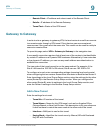
VPN
Gateway to Gateway
Cisco RV320/RV325 Administration Guide 83
9
• Remote Client—IP address and subnet mask of the Remote Client.
• Details—IP address of the Remote Gateway.
• Tunnel Test—Status of the VPN tunnel.
Gateway to Gateway
In a site-to-site or gateway-to-gateway VPN, the local router at one office connects
to a remote router through a VPN tunnel. Client devices can access network
resources as if they were all at the same site. This model can be used for multiple
users at a remote office.
To open this page, select VPN > Gateway to Gateway in the navigation tree.
A successful connection requires that at least one of the routers to be identifiable
by a static IP address or a Dynamic DNS hostname. Alternatively, if one router has
only a dynamic IP address, you can use any email address as authentication to
establish the connection.
The two ends of the tunnel cannot be on the same subnet. For example, if the
Site A LAN uses the 192.168.1.x/24 subnet, Site B can use 192.168.2.x/24.
To configure a tunnel, enter corresponding settings (reversing local and remote)
when configuring the two routers. Assume that this router is identified as Router A.
Enter its settings in the Local Group Setup section; enter the settings for the other
router (Router B) in the Remote Group Setup section. When you configure the
other router (Router B), enter its settings in the Local Group Setup section, and
enter the Router A settings in the Remote Group Setup section.
Add a New Tunnel
Enter the settings for a tunnel:
• Tunnel No—ID number of the tunnel.
• Tunnel Name—Name for this VPN tunnel, such as Los Angeles Office,
Chicago Branch, or New York Division. This description is for your reference.
It does not have to match the name used at the other end of the tunnel.
• Interface—WAN port to use for this tunnel.
• Keying Mode—Identifies the tunnel security: Manual, IKE with Preshared
Key, IKE with Certificate.


















